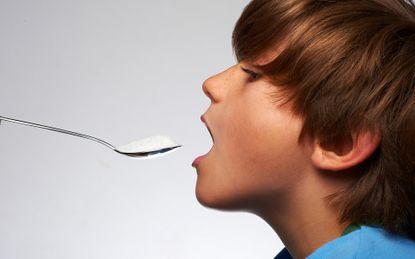Daily sugar allowance for children: How much sugar should children have?


The daily sugar allowance for children varies depending on age, but even with guidelines in place research shows children are eating too much of the sweet stuff.
That's not just because it's delicious – so delicious in fact that sugar is hard to quit, as those who've tried the sugar-free diet will tell you – but because it's everywhere, making it very difficult for parents to stick to the daily sugar allowance for children. ‘Sugar is a really palatable food, meaning that kids enjoy it and want to eat it in excess,’ explains baby and child nutritionist Charlotte Stirling-Reed. 'But too much sugar can put children at an increased risk of weight gain,' says dietitian Sarah Almond Bushell.
And that's not all. ‘When a child consumes too much sugar in the form of simple sugars or highly refined starchy foods their blood sugar levels spike, which can result in hyperactivity and poor concentration at school. A regular rise and fall in blood sugar levels has been associated with a possible impact on a child’s mood, behaviour and energy,’ adds Dr Andrew Raffles, consultant paediatrician at The Portland Hospital, which is part of HCA Healthcare UK. ‘Consuming too much sugar during childhood can also lead to unhealthy cravings and habits later in life,’ he says.
Sugar is also bad news for teeth. 'When sugar is consumed it interacts with the bacteria within the plaque to produce acid,' says Sarah MacDonald, an orthodontic therapist and brand ambassador for Beverly Hills Formula. 'This acid slowly dissolves the enamel, creating holes or cavities. Tooth decay may lead to tooth abscesses, which can lead to tooth pain and result in the tooth having to be removed. Children can be more prone to these negative effects due to the enamel in baby teeth being weaker than that of adult teeth,' she warns.
What is the daily sugar allowance for children and how much sugar should children have?
The NHS recommends the following daily sugar allowance for children (in free, or added, sugars):
- There are no guidelines for children 4 and under but avoid sugar-sweetened food and drink
- 4 to 6-year-olds: no more than 19g = 5 sugar cubes free sugars
- 7 to 10-year-olds: no more than 24g = 6 sugar cubes free sugars
- 11 to years-old to adults: no more than 30g = 7 sugar cubes free sugars. If you struggle, try this sugar-free diet.
But in 2019, a Public Health England report revealed that, by the time they are 10, the daily sugar allowance for children was being exceeded. So much so it's on par with that of an 18-year-old's. The same report found that children are consuming eight sugar cubes per day above the recommended amount. That’s a whopping extra 2,800 sugar cubes a year. The main culprits are the free sugars added to soft drinks and foods such as cakes, pastries, preserves, biscuits, cereal, sweets, yoghurt, ice cream and puddings. Free sugars can also be found in juices, honey and syrup – while natural, they should be consumed in moderation.
According to Public Health England’s Health Profile, nearly 4 in 10 children aged 10 or 11 will be obese by 2024. Meanwhile, the World Health Organisation has linked excessive sugar intake to childhood obesity. ‘Eating sugar in excess can lead to children eating more calories than they need and could lead to them gaining excess weight,’ confirms Charlotte. 'The child may become at risk of obesity, which can result in significant health risks including high blood pressure, high cholesterol levels and increased risk of type 2 diabetes,’ adds Dr Raffles.
GoodtoKnow Newsletter
Parenting advice, hot topics, best buys and family finance tips delivered straight to your inbox.
Sugar in children's drinks
‘There are guidelines around the daily sugar allowance for children that manufacturers should add to children’s food and drinks but no strict regulations,’ says Charlotte. ‘A report from Public Health England recommends that the government needs to “align manufacturers in a direction that better supports their (children’s) future health.” There’s some work going on around this, but it’s voluntary and at the discretion of individual manufacturers,' she says.
‘It’s best to try and swap the majority of young children’s drinks to water, milk and low-sugar alternatives,’ she continues. ‘Sugary drinks [such as soda – see which ones are the worst offenders are here – juice drinks, squashes, cordials, energy drinks and juice] account for almost a third of children’s daily sugar intake.' In one can of cola alone, there are an astounding NINE sugar cubes – more than the recommended amount children or adults should consume daily.
Indeed, new research from the University of Michigan found that while eating foods like salmon increases our lifespan by 16 minutes, every fructose-filled soft drink we swallow removes 12.5 minutes from our life expectancy.
It isn’t just soda that contains huge amounts of sugar. So do fruit juice drinks and smoothies, which are often given to children in the belief that they're healthier. A 2016 study from the University of London and University of Liverpool found that of 203 children’s drinks found in major supermarkets, most would receive a red-coloured label for sugars per 200ml serving. These included around 85 drinks filled with at least 19g of sugars. That's a whole day’s allowance for 4 to 6 year-olds in one drink.
Sarah advises we limit our children’s ‘fruit juice and smoothies to just 100ml once a day.’ Does this mean fruit is bad for our kids? Not at all. 'However, while fruit contains natural sugars, which are less likely than refined sugars to have negative consequences for a child’s health, once blended into a smoothie or a juice these sugars are released making them more damaging,’ says Dr Raffles.
Dr Raffles continues: ‘Parents should encourage children to eat fruit in its natural form. The structure of fruit means the body has to break down the cells before sugar is released. The sugar is then absorbed into the blood slowly, raising blood sugar levels in a controlled manner and preventing overconsumption.'
Sugar in children's food
With so much sweet food available it can be difficult for us – and our kids – to resist. 'But food such as sweets, cakes, biscuits, chocolate and fizzy drinks are high in free sugars so should not be included as part of a child’s regular diet,’ advises Dr Raffles.
Other – less likely – products come with some health risks. ‘Dairy is a vital part of a child’s diet, but some dairy products targeted at children – such as flavoured yoghurts – contain high quantities of added sugar,’ he continues. ‘Parents should also take care offering children ready meals and ketchup, salad cream, marinades and chutneys. These foods often contain high levels, too.’
Dr Raffles admits that current information is confusing at best and misleading at worst. ‘It isn't always easy to tell which foods are good choices and which aren't,’ he says. ‘The traffic light label system – which uses the colours green, amber and red to indicate if there's a healthy or unhealthy amount of each category per 100g – is an effective system for spotting sugar. But remember that quantifying amounts are very small. For example, in food, 100g only amounts to the size of a medium tomato or banana. So, when buying meals that are 300g or 400g in total, even a green traffic light rating could be much more than originally thought,’ he explains.
Be aware that sugar comes in many forms, including corn sugar, glucose, maltose, molasses and sucrose – to name a few (see the list of sugars on the NHS website). Dr Raffles recommends ‘providing healthy snacks between meals, such as hummus and carrot sticks, rather than chocolate and sweets. This is one straightforward way to cut down sugar consumption.’

Top tips for making sure kids don’t have too much sugar
If possible, nip your child’s sugar intake in the bud early. ‘Keep sweet foods to a minimum for under 2s. Babies are born with a natural desire for sweet foods but need to learn to like non-sweet foods or it discourages this learning for bitter and sour flavours such as vegetables,’ says Sarah. ‘Sweet foods that babies can have are fruit and natural yoghurt sweetened with fruit – but little else,’ she says.
‘For 2-4-year-olds, be aware that they still have this strong desire for sweet,' she continues. 'But avoiding sweet foods can backfire as they simply become more desirable. I suggest offering regular small portions so that children learn that they do have sweet foods. Just not as often as other foods such as pasta or carrots.’
Are there healthier sugars parents can offer their young kids instead? ‘There's honey (not for under 1s), maple syrup, brown rice syrup, agave and alternative sugars such as coconut sugar,' says Sarah. ‘However, these are sugars – they just go by another name! There are no additional health benefits to using these despite what you might read!’ Opt for mashed bananas, apples or dates to sweeten food.
Certain foods – however tempting or cute the packaging – are particularly sweet. These are ‘some children’s yoghurts, some children breakfast cereals, cereal bars, and toddler fruit snacks (apple crisps, fruity bakes, fruit leathers),’ says Sarah.
You also need to consider the effect of sugar on your children's teeth. If you're concerned about your children's teeth orthodontic therapist Sarah McDonald suggests:
- Avoiding sticky sweets: sticky carbohydrates stay on the teeth, making it more likely for bacteria to produce acid. When choosing a sweet treat, avoid foods that stick to the teeth, like toffees, etc.
- Replacing sugar with sugar alternatives: Sugar alcohols like xylitol can actually enhance dental health.
- Snacking less frequently: Eating sweet foods on a regular basis can raise the risk of tooth decay. Limit sugar to mealtimes.
- Not giving sugar at bedtime: Putting a child to bed with a bottle that contains anything other than plain water exposes their mouth to sugar throughout the night.
Low-sugar children's meal ideas
Breakfasts
Encourage your children to enjoy a savoury breakfast such as a boiled egg and soldiers, an omelette, or toast with Marmite or cream cheese. If they really want something sweet opt for porridge with fresh fruit and spices or a little honey or fruit compote. If they love cereal go for low or no-added sugar cereals such as Weetabix, Shredded Wheat, and some muesli brands. Or make your own muesli. You could also make two ingredient banana pancakes – an easy breakfast that will contribute to your child’s 5-a-day.
Snacks
Lunchbox fillers are a common problem when it comes to sugar. You might think a fruit yoghurt seems like a healthy snack, but some brands contain as much as 5tsps of sugar per pot! Look for naturally sweetened fruit yoghurts or plain Greek yoghurt which you can add fruit to. Swap shop-bought snacks like cereal bars and biscuits for homemade versions, so you know what's in them. Some easy but tasty ideas include:
- Healthy muffins
- Hummus with sweet vegetable sticks such as red pepper and carrots
- Porridge bars
Lunches
Avoid sugary white breads. Hovis Soft White Thick Bread, for example, has 1.7g sugar in every slice. Warburtons Speciality Multi-Grain and Seed Bread is a better choice – with 0.7g sugar per slice. Check packets to see which option has the lowest sugar. If your child likes pasta you could ditch sandwiches altogether in favour of a pasta box like our sunshine chunky pasta. You can include lots of colourful veggies to help them on their way to their 5-a-day.
Dinners
When it comes to dinner, savoury staples can provide an unnecessary sugar hit. And not just the mains – some condiments add a hefty dose of sugar. For instance, Heinz ketchup contains nearly 4g of sugar per squirt. Regard it as a treat, rather than an essential accompaniment. Other favourites that contain hidden sugars include:
- Tinned soups
- Ready-made meals and pizzas
- Pasta sauces
Where you can, try making your own. Homemade tomato sauce can be made in bulk and used for both pizza and pasta dinners. Plus, the kids will love helping you cook from scratch. As a general rule, making your own healthy family meals is the best option for a balanced diet.
Desserts It’s no surprise that desserts contain sugar, but rather than banishing treats make smarter choices for your little ones. For instance, frozen mango blitzed in a food processor makes a delicious sorbet-like dessert. And strawberries with a little cream always go down a treat.
Change 4 Life sugar-checking app
For more info, head to the Change 4 Life website, where you can find plenty of useful resources including an app to scan food labels while shopping so you can keep within the daily sugar allowance for children.

Debra Waters is an experienced online editor and parenting writer. She also has a strong background on health, wellbeing, beauty, and food. She currently writes for Goodto and Woman&Home, and print publications Woman, Woman’s Own, and Woman’s Weekly. Debra has written for What to Expect, Everyday Health, and Time Out. In addition, she has had articles published in The Telegraph and The Big Issue.
-
 Psychologist shares the real reason parents - especially celebrity mums and dads - choose unique baby names and it kind of makes sense
Psychologist shares the real reason parents - especially celebrity mums and dads - choose unique baby names and it kind of makes senseUnique baby names are on the rise, and a psychologist has shared the surprisingly relatable reason why many choose such unusual monikers.
By Lucy Wigley Published
-
 Teachers told to look out for ‘sextortion’ victims in schools as cases rise and boys are ‘most vulnerable’ - here’s everything you need to know
Teachers told to look out for ‘sextortion’ victims in schools as cases rise and boys are ‘most vulnerable’ - here’s everything you need to knowSextortion cases have doubled, leading to teachers being issued guidance to spotting the signs - teenage boys are the biggest demographic being targeted.
By Lucy Wigley Published